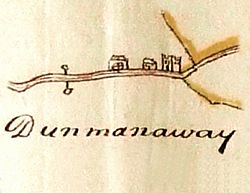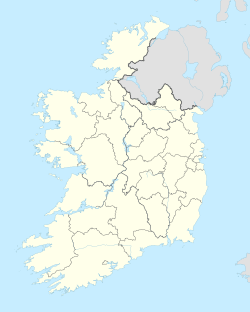Dunmanway Castle facts for kids
Quick facts for kids Dunmanway Castle |
|
|---|---|
| County Cork, Ireland | |

A schematic representation of Dunmanway Castle from a Down Survey map of the Parish “Funlobbish and Kilmichil” c.1655-1658.
|
|
| Coordinates | 51°43′11″N 9°07′06″W / 51.719794°N 9.118257°W |
| Type | Fortified tower house |
| Site information | |
| Controlled by | The MacCarthys of Gleannacroim The Arnopp family The Cox family |
| Condition | Demolished |
| Site history | |
| Built | c. 1480s |
| Built by | Katherine Fitzgerald, Lady of Hy-Carbery |
Dunmanway Castle (in Irish: Dún Mánmhaí) was a strong tower house built in the late 1400s. It once stood by the Sally River in the town of Dunmanway, County Cork, Ireland. This castle was the main home for the MacCarthys of Gleannacroim.
Later, in the late 1600s, the castle was taken over by the government. It was then given to a soldier named William Arnopp. There are stories that the castle was taken apart after it was sold to the Cox family in 1692. People say its stones were used to build a flour mill nearby.
Contents
The Story of Dunmanway Castle
Who Built Dunmanway Castle?
Old records, like the Annals of the Four Masters, say that "Dun-na-m-beann" (Dunmanway Castle) was built by Catherine Fitzgerald. She was the daughter of the 7th Earl of Desmond. Catherine was also married to Finghin MacCarthy Reagh. It's believed this was the first tower house built in this part of Carbery.
The MacCarthy Family and the Castle
From the mid-1200s, the area around Dunmanway was controlled by the MacCarthys of Gleannacroim. They were related to the powerful MacCarthy Reaghs of Carbery. We don't know exactly when the MacCarthys of Gleannacroim took over the castle. But it might have happened after Catherine's death in 1506. This would have helped them keep control of the area.
In 1584, the clan leader Tadhg-an-Fhorsa I was pardoned for his part in the Desmond Rebellions. This meant he could keep his land and goods. Later, in 1590, he gave his lands to Queen Elizabeth I. She then gave them back to him as his own property. This included "the castle and lands of Donemayneway." He had to promise to keep ten foot soldiers ready for the queen's service.
Changes in Control
In 1602, the castle was reportedly taken by the 4th Earl of Thomond. This happened because Tadhg-an-Fhorsa I was involved in the Nine Year's War. The government wanted to take over important castles like Dunmanway.
In 1615, Tadhg-an-Fhorsa I again gave his estate to the king, James I, and got it back. When he died in 1618, Dunmanway Castle went to his older son, Tadhg-an-Duna I.
Tadhg-an-Duna I was also known as Tadhg-na-Feile, which means "of the hospitality." He was famous for being very generous while living in Dunmanway Castle. A poet once wrote that Ireland had no leader as kind as Tadhg-na-Feile.
The Castle is Taken Over
Tadhg-an-Duna I was involved in the Irish Rebellion of 1641. Because of this, much of his land was taken away during the Cromwellian confiscations. This meant the government took control of his property.
Maps from 1655-58 show "one castle and mill on Dunmanaway" belonging to "Teig Carthy als Downe." In 1652, Tadhg's wife, Honor O'Donovan, and their youngest son were living in the castle. However, the MacCarthy lands were given to new owners by King Charles II.
In 1666, a soldier named Lt-Colonel William Arnopp was given ownership of Dunmanway and Togher lands. By 1670, William Arnopp was officially listed as the owner of Dunmanway, which included the castle.
The Castle's Final Days
In 1692, Peirce Arnopp, William's son, sold his family's land around Dunmanway to Sir Richard Cox. Sir Richard Cox became the main landowner in the area. He also worked hard to develop the town of Dunmanway.
There are different stories about how the castle was destroyed. Some say Sir Richard Cox had it taken down. He might have used its stones to build his own mansion, the "Market House," and the "Long Bridge" over the River Bandon. Other accounts say the castle walls were still standing until around 1830.
George Bennett wrote in 1869 that "not even one stone" of the castle was left. He said its walls and foundations were dug up years before. The stones were used to build a flour mill nearby.
A Hidden Chamber Discovered
Bennett also wrote about something amazing found during the castle's demolition. Workers found a secret underground room. After clearing away earth and rubble, they went down into what seemed to be a storage room. This room might have been where the Geraldines and MacCarthys kept food supplies.
The room had several sections, mostly filled with native wheat. The sections were in good condition. But the wheat itself had shrunk and changed color over time. It was as hard and black as small stones.
What Does "Dunmanway" Mean?
The name "Dunmanway" has a few possible meanings. Some believe it comes from older settlements in the area. One idea is that it was the site of "Duncoba," a home of the King of the Ui Eachach.
However, many think the name of the area changed because of the castle itself. The castle influenced the name of the townland and the town that grew around it.
The Irish name "Dúnmaonmhuighe" or "Dúnmaonmhuí" has different interpretations. Some think it combines ideas of the land and the castle. It could mean "the castle of the yellow river" or "fort of the middle plain."
But according to the Irish language expert John O'Donovan, the name describes only the castle. He believed it meant "the fort of the gables or pinnacles."
Another idea from the History of Bandon is that it means "the fort of the yellow women." This name might have been used by the Irish for Spanish soldiers who were at the fort. They might have called them "yellow women" because of their skin color or their cloaks. This story might also be linked to Spanish coins found where the castle once stood.


